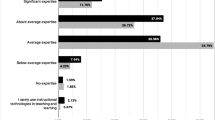Abstract
Most academic technology areas of higher education institutes do not feel faculty technology adoption is adequate (Hartman (EDUCAUSE Rev 43(6), 2008)). Among the barriers to instructional technology adoption are faculty self-efficacy and background. Self-efficacy encompasses the faculty member’s belief or confidence in his ability to succeed. Background barriers include the instructor’s previous experiences. Faculty members adopting new technologies for teaching and learning are facing a series of obstacles based on their self-efficacy and background as sound adoption requires changes in both technology and pedagogy. In addition, many technologies and pedagogies require comfort with underlying skills. As academic technologists, we need to appreciate the levels of comfort that instructors need in order to be open to new technologies. In addition to Rogers’ innovation curve, we need to be aware of the factors involved in deciding to adopt as well as the stages instructors go through in their decision making. Examples of specific actions are provided.











Similar content being viewed by others
Explore related subjects
Discover the latest articles, news and stories from top researchers in related subjects.References
Abbitt, J. T., & Klett, M. D. (2007). Identifying influences on attitudes and self-efficacy beliefs towards technology integration among pre-service educators. Electronic Journal for the Integration of Technology in Education, 6, 28–42.
Bandura, A. (1994). Self-efficacy defined. In V. S. Ramachaudran (Ed.), Encyclopedia of human behavior (Vol. 4, pp. 71–81). NY: Academic. Retrieved from http://www.uky.edu/~eushe2/Bandura/BanEncy.html.
Chickering, A.W., & Gamson, Z.F. (1987). Seven principles for good practice in undergraduate education. Retrieved August 22, 2012, from http://www.aahea.org/articles/sevenprinciples1987.htm.
Colorado State University. (n.d.). Academic Computing and Networking Services. Retrieved September 25, 2015, from http://www.acns.colostate.edu/Search.aspx?q=webex&btnSearch=Search.
Galavotti, C., Cabral, R. J., Lansky, A., Grimley, D. M., Riley, G. E., & Prochaska, J. O. (1995). Validation of measures of condom and other contraceptive use among women at high risk for HIV infection and unintended pregnancy. Health Psychology, 14(6), 570–578. doi:10.1037/0278-6133.14.6.570.
Haddoune, A.S. (2009). Reflection on students’ self-efficacy expectancies: paving the path to better achievement outcomes in higher education. Retrieved from http://www.oecd.org/edu/imhe/43977414.pdf.
Hartman, J.L. (2008). Moving teaching and learning with technology from adoption to transformation. EDUCAUSE Review, 43(6). Retrieved from http://er.educause.edu/articles/2008/10/moving-teaching-and-learning-with-technology-from-adoption-to-transformation.
Indiana University. (n.d.). Academic Resources. IUware. Retrieved September 25, 2015, from http://iuware.iu.edu/Windows/List/158.
Marcus, B. H., Selby, V. C., Niaura, R. S., & Rossi, J. S. (1992). Self-efficacy and the stages of exercise behavior change. Research Quarterly for Exercise and Sport, 63(1), 60–66. doi:10.1080/02701367.1992.10607557.
Purdue University. (n.d.). Information technology at purdue. Retrieved September 25, 2015, from http://www.itap.purdue.edu/learning/teach/index.html.
Reid, P. (2012). Categories for barriers to adoption of instructional technologies. Education and Information Technologies, 1–25. doi:10.1007/s10639-012-9222-z.
Rogers, E. (2003). Diffusion of innovations (5th ed.). New York: Free Press.
Schunk, D. H. (1991). Self-efficacy and academic motivation. Educational Psychologist, 26(3–4), 207–231.
Siegle, D. (2000). Self-efficacy intervention. Retrieved September 26, 2015, from http://www.gifted.uconn.edu/siegle/selfefficacy/section0.html.
University of Cincinnati. (n.d.). Canopy - blackboard portal. Retrieved September 25, 2015, from http://www.uc.edu/content/uc/canopy/portal.html.
Watson, C.E. (2007). Self-efficacy, the innovation-decision process, and faculty in higher education: Implications for faculty development. Virginia Polytechnic Institute and State University. Retrieved from http://scholar.lib.vt.edu/theses/available/etd-04102007-220540/.
Author information
Authors and Affiliations
Corresponding author
Rights and permissions
About this article
Cite this article
Reid, P. Supporting instructors in overcoming self-efficacy and background barriers to adoption. Educ Inf Technol 22, 369–382 (2017). https://doi.org/10.1007/s10639-015-9449-6
Published:
Issue Date:
DOI: https://doi.org/10.1007/s10639-015-9449-6




